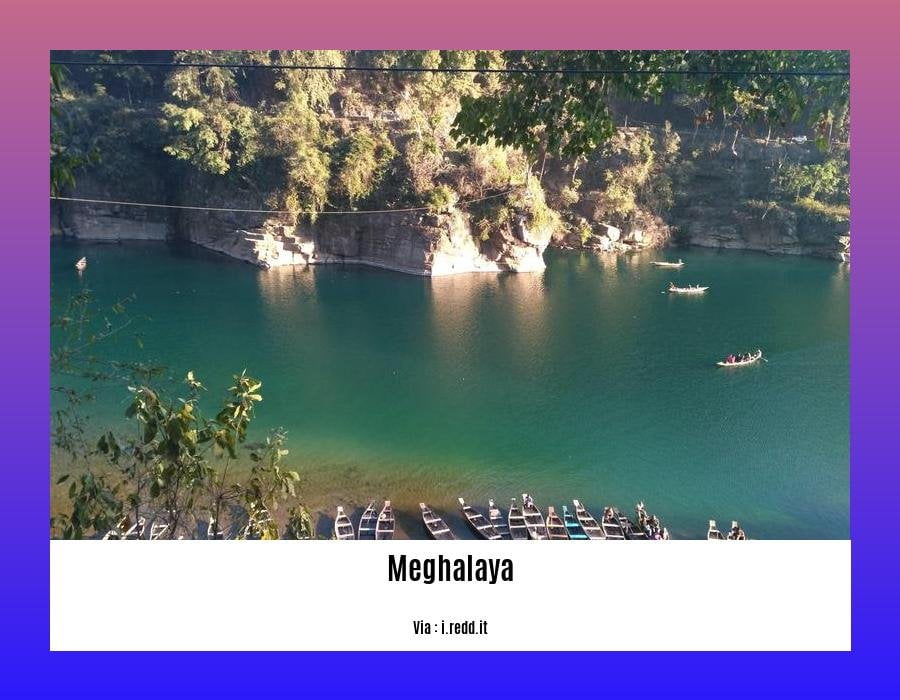Protecting the Precious: Preserving Endangered Species in Meghalaya’s Fragile Ecosystem
As our world grapples with the increasing threats to biodiversity, it is crucial to shine a spotlight on the unique and vulnerable species that call Meghalaya home. Nestled in the heart of Northeast India, this enchanting region boasts a fragile ecosystem teeming with a remarkable array of flora and fauna. However, the alarming decline in endangered species in Meghalaya is a stark reminder of the urgent need for conservation efforts. In this article, we delve into the pressing issues faced by these magnificent creatures and the vital role we must play in safeguarding their future.
Key Takeaways:
– Meghalaya is home to several endemic and endangered species that are crucial for maintaining the ecological balance.
– Some of the endemic and endangered species found in Meghalaya include Adinandra griffithii, Ceropegia arnottiana, Clematis apiculata, Elaeagnus conferta ssp. dendroidea, Eriocaulon barba-caprae, Goniothalamus simonsii, Ilex venulosa, Livistona jenkinsiana, Ophiorrhiza subcapitata, and Trivalvaria kanjilalii.
– Meghalaya is also known for its important tree species, including the Oriental White-backed Vulture, Slender-billed Vulture, White-winged Duck, and Greater Spotted Eagle.
– The endemic and endangered species face threats such as habitat loss, illegal wildlife trade, climate change, and invasive species.
– Conservation efforts for protecting these species include habitat conservation, strict law enforcement, public awareness and education, and research and monitoring.
– By implementing these conservation measures and involving the local communities, Meghalaya can preserve its natural heritage for future generations.
Endangered Species in Meghalaya: A Struggle for Survival

Introduction
Meghalaya, nestled in the northeastern region of India, boasts a remarkable wealth of biodiversity and unique ecosystems. However, this natural heritage is under threat as numerous species face the risk of extinction. In this article, we will explore some of the endangered species that call Meghalaya home, highlighting the urgent need for conservation efforts to protect them.
The Plight of Endemic Species
Meghalaya is home to several endemic species that are found nowhere else in the world. These species are not only unique but also incredibly vulnerable to habitat loss and other threats. Let’s dive into some of these remarkable species:
Adinandra griffithii: This plant species, endemic to Meghalaya, teeters on the brink of extinction. Its delicate foliage and blossoming blooms make it a true gem of the region.
Ceropegia arnottiana: Another endemic plant, Ceropegia arnottiana, faces an uncertain future. Its slender stems and enchanting flowers make it a sight to behold.
Clematis apiculata: With its intricate vine-like structure and vibrant flowers, Clematis apiculata adds a touch of elegance to Meghalaya’s ecosystems. Unfortunately, it treads a perilous path towards extinction.
These are just a few examples of the endemic species fighting for survival in Meghalaya. The list goes on, each species representing a thread in the intricate tapestry of the region’s biodiversity.
Threats and Challenges
The endemic species in Meghalaya face numerous challenges that threaten their existence. Habitat loss, primarily due to deforestation and urbanization, is a significant threat. As human activities encroach upon natural habitats, these unique plants and animals lose their homes.
Illegal wildlife trade and poaching also wreak havoc on the delicate balance of Meghalaya’s ecosystems. The demand for exotic species continues to fuel this destructive trade, further endangering already vulnerable populations.
Climate change and habitat degradation pose additional challenges. Rising temperatures and changing weather patterns disrupt the delicate relationships between species, leading to potential cascading effects throughout the ecosystem. Invasive species complicate matters further, as they outcompete and displace native species, disrupting the intricate web of life.
Conservation Efforts: A Hopeful Path Forward
To protect the invaluable natural heritage of Meghalaya, concerted efforts from all stakeholders are essential. Here are some recommendations to drive conservation initiatives:
Habitat Conservation: Establishing protected areas and wildlife sanctuaries is crucial for preserving the habitats of endangered species. These safe havens provide a refuge where these species can thrive.
Law Enforcement: Strengthening and enforcing stringent laws and regulations against wildlife trafficking and poaching is vital. This sends a clear message that such activities will not be tolerated.
Public Awareness and Education: Educating local communities and raising awareness about the importance of biodiversity conservation is instrumental in garnering support for conservation efforts.
Research and Monitoring: Conducting scientific research and monitoring programs helps us understand the status of endangered species and assess the effectiveness of conservation strategies.
By implementing these conservation measures and fostering a sense of stewardship among the local communities, we can create a sustainable future for both the endangered species and the unique ecosystems they inhabit.
Conclusion
The endangered species of Meghalaya are not only a treasure of their homeland but also a global responsibility. It is in our hands to ensure their survival and protect the fragile balance of the region’s ecosystems. By coming together and taking proactive conservation measures, we can safeguard Meghalaya’s natural heritage for generations to come. Let us rise to the challenge and be the guardians of these extraordinary species, safeguarding their rightful place in the tapestry of life.
References:
1. Important Tree Species of Meghalaya | Official …
2. List the 20 endangered species in Meghalaya – …
India is home to a diverse range of flora and fauna. If you want to learn about endangered animals and birds in India, click here. Let’s explore the rich wildlife heritage of India!
If you are interested in discovering the endangered animals in India, click here. Get ready to be amazed by the incredible and vulnerable species that dwell in this beautiful country.
For an up-close encounter with endangered plants in South America, look no further than this link. Prepare to be enchanted by the fragile beauty of these endangered floral treasures.
Causes of Endangerment

Key Takeaways:
- Meghalaya, a state in northeastern India, is home to a diverse range of endangered species.
- Threats to these species include habitat loss, illegal wildlife trade, climate change, habitat degradation, and invasive species.
- Conservation efforts should focus on habitat conservation, law enforcement against wildlife trafficking and poaching, public awareness and education, and research and monitoring.
- The responsibility for protecting these endangered species lies with all stakeholders, including local communities and governments.
- Preserving Meghalaya’s natural heritage is crucial for future generations.
Endangered species in Meghalaya face numerous challenges that have pushed them to the brink of extinction. Habitat loss is one of the primary causes of endangerment, with human activities such as deforestation and infrastructure development encroaching on their habitats. As a result, these species are left with limited space to survive and reproduce.
Illegal wildlife trade and poaching also pose significant threats to the survival of endangered species in Meghalaya. Turtles, tortoises, lizards, and other endangered animals are targeted for their valuable body parts, which are sold in illegal markets. This not only depletes their populations but also disrupts the delicate balance of the ecosystem.
The impacts of climate change are becoming increasingly evident in Meghalaya, further exacerbating the challenges faced by endangered species. Rising temperatures, changing rainfall patterns, and extreme weather events disrupt the fragile ecosystems these species depend on, making it difficult for them to adapt and survive.
Habitat degradation is another key factor contributing to the endangerment of species in Meghalaya. Pollution, invasive species, and overexploitation of resources degrade the quality of their habitat, making it inhospitable for their survival.
Conservation efforts must prioritize habitat conservation as a crucial measure to protect endangered species in Meghalaya. This involves preserving and restoring their natural habitats, ensuring they have sufficient resources to thrive.
Law enforcement against wildlife trafficking and poaching is essential to curb the illegal trade that threatens the survival of endangered species. Strict regulations, penalties, and targeted law enforcement efforts are necessary to deter poachers and protect these vulnerable animals.
Public awareness and education play a vital role in fostering a culture of conservation in Meghalaya. By raising awareness about the importance of protecting endangered species and their habitats, we can encourage responsible behaviors and support for conservation initiatives.
Research and monitoring are essential for understanding the threats faced by endangered species and developing effective conservation strategies. This includes studying their biology, behavior, and ecological requirements, as well as monitoring population trends and the impacts of conservation efforts.
The responsibility for protecting endangered species in Meghalaya lies with all stakeholders, including local communities and governments. Collaborative efforts involving community participation, policy implementation, and sustainable practices are necessary to ensure the long-term survival of these endangered species.
In conclusion, the causes of endangerment in Meghalaya’s fragile ecosystem are primarily driven by habitat loss, illegal wildlife trade, climate change, habitat degradation, and invasive species. By addressing these challenges through habitat conservation, law enforcement, public awareness, and research, we can make a significant impact in protecting the precious biodiversity found in Meghalaya for future generations.
Sources:
- Meghalaya Biodiversity Board – Threatened Faunal Species in Meghalaya
- Forests & Environment Department, Government of Meghalaya – Endangered Species Photo Gallery
Impacts of Habitat Loss on Endangered Species
Key Takeaways:
- Habitat loss is the greatest threat to species, and it continues to occur due to human consumption and industrial development.
- The loss of habitat can result in the decline and eventual extinction of endangered species.
- The destruction of habitat not only affects individual species but also impacts the health of the global ecosystem.
- The loss of 90% of habitat could lead to the loss of 30%-60% of dependent species.
- Identification, restoration, and management of habitat are crucial for the conservation of endangered species.
- Habitat acquisition plays a significant role in protecting and preserving endangered species.
Habitat loss is a critical issue that poses a major threat to endangered species in Meghalaya and worldwide. As human consumption and industrial development continue to expand, our forests, swamps, plains, and other habitats are being destroyed at an alarming rate. This destruction has far-reaching consequences for the species that call these habitats home and for the overall health of our planet’s ecosystem.
But what exactly are the impacts of habitat loss on endangered species?
The consequences of habitat loss are dire. When habitats are reduced or degraded, species face the risk of being lost forever. It is estimated that if 90% of habitat is destroyed, we could lose anywhere from 30% to 60% of species that depend on those habitats. This not only results in the loss of biodiversity but also disrupts the delicate balance of ecosystems and threatens the survival of countless other species.
To protect endangered species, it is crucial to take site-specific actions that involve the identification, restoration, and management of habitat. By focusing on protecting and preserving existing habitats, we can provide a safe haven for endangered species and promote their recovery.
In addition to habitat conservation, habitat acquisition plays a significant role in safeguarding endangered species. By acquiring additional land and converting it into protected habitat, we can create safe spaces for species threatened by habitat loss. This approach allows us to actively expand the areas available for endangered species to thrive and provides a buffer against the encroachment of human activities.
The impact of habitat loss on our planet’s ability to sustain life cannot be overstated. It is one of the biggest threats to plant and animal species worldwide. Agriculture, housing, roads, pipelines, and industrial development all contribute to habitat loss, further exacerbating the problem. Efforts to curb these destructive activities and promote sustainable land use are crucial for the long-term survival of endangered species and the preservation of our delicate ecosystems.
The COVID-19 pandemic has provided a silver lining in terms of habitat regeneration. As human activities slowed down during lockdowns, some habitats had the chance to recover and restore themselves. However, it is vital that we do not become complacent. The challenges posed by habitat loss on endangered species remain pressing, and only through continued action and awareness can we hope to protect and preserve these invaluable treasures.
Sources:
- WWF. “Habitat Loss & Degradation.” Retrieved from
- IntechOpen. “The Economics of Endangered Species in Hawaii during the Pandemic.” Retrieved from
Conservation efforts and the way forward
In the northeastern state of Meghalaya, the iconic mahseer fish species faced a decline in populations due to overexploitation and habitat degradation. To protect this culturally and ecologically important fish, community conservation efforts were initiated, leading to the establishment of fish sanctuaries and the implementation of fishing bans. This success story of community conservation in Meghalaya showcases the environmental and socio-economic benefits that have been achieved.
A Fishing Ban That Led to The Fish Sanctuaries:
Recognizing the need for conservation, the indigenous communities of Meghalaya implemented a fishing ban to address the overexploitation of fish resources and habitat degradation. This ban served as a crucial step towards the establishment of fish sanctuaries, providing safe havens for the mahseer fish species to recover and thrive. These sanctuaries have become vital for the preservation of fish populations and the overall ecological balance.
Lessons from The Past:
One important lesson that emerged from the conservation efforts in Meghalaya is the need for tailored approaches that consider the motivations and priorities of each community. While fish sanctuaries have been successfully established in some areas, it is important to acknowledge that they are not found across all parts of Meghalaya. By understanding and addressing the specific needs and motivations of different communities, conservation efforts can be more effective and inclusive.
Environmental and Socio-Economic Benefits:
The conservation of fish populations and the establishment of fish sanctuaries in Meghalaya have yielded significant environmental and socio-economic benefits. While fish remains an important dietary component for the indigenous communities, they are now able to fish beyond the stretches of the sanctuaries, ensuring a sustainable balance between conservation and livelihoods. This approach fosters community involvement in conservation efforts and supports the overall well-being of both the ecosystems and the indigenous communities.
Key Takeaways:
- Community conservation efforts in Meghalaya have successfully protected the mahseer fish species through the establishment of fish sanctuaries and fishing bans.
- Tailored conservation approaches are necessary to address the specific motivations and priorities of different communities.
- The conservation of fish populations has led to environmental and socio-economic benefits, allowing for sustainable livelihoods and preserving the biodiversity of the region.
URL Sources:
- India Mongabay – Fish Sanctuaries and Community Conservation
- Meghalaya Biodiversity Board – Threatened Faunal Species in Meghalaya
Citations:
India Mongabay. “Fish Sanctuaries and Community Conservation.” Mongabay India, 2021, india.mongabay.com/2021/08/fish-sanctuaries-and-community-conservation/.
Meghalaya Biodiversity Board. “Threatened Faunal Species in Meghalaya.” Official website of Meghalaya, megbiodiversity.nic.in/threatened-faunal-species-meghalaya.
FAQ
Q1: What are some of the endangered species found in Meghalaya?
A1: Some of the endangered species found in Meghalaya include Adinandra griffithii, Ceropegia arnottiana, Clematis apiculata, Elaeagnus conferta ssp. dendroidea, Eriocaulon barba-caprae, Goniothalamus simonsii, Ilex venulosa, Livistona jenkinsiana, Ophiorrhiza subcapitata, and Trivalvaria kanjilalii.
Q2: What are the threats faced by endemic and endangered species in Meghalaya?
A2: The threats faced by endemic and endangered species in Meghalaya include habitat loss due to deforestation and urbanization, illegal wildlife trade and poaching, climate change and habitat degradation, and invasive species that disrupt the local ecosystem.
Q3: How can we protect the endemic and endangered species in Meghalaya?
A3: Conservation efforts to protect the endemic and endangered species in Meghalaya can include establishing protected areas and sanctuaries to safeguard their habitats, enforcing stringent laws and regulations against wildlife trafficking and poaching, conducting awareness campaigns to educate the local communities about the importance of biodiversity conservation, and carrying out scientific research and monitoring programs to gather data on species populations and assess their conservation status.
Q4: What is the importance of preserving the endangered species in Meghalaya?
A4: Preserving the endangered species in Meghalaya is important for maintaining the ecological balance and biodiversity of the region. These species play vital roles in the ecosystem and contribute to the overall health and stability of the environment. Additionally, they hold cultural and scientific value and provide unique opportunities for research and education.
Q5: What are some of the conservation efforts in Meghalaya to protect endangered species?
A5: Conservation efforts in Meghalaya to protect endangered species include the establishment of fish sanctuaries, implementation of fishing bans, involvement of local communities in conservation initiatives, and the collaboration of government bodies, NGOs, and individuals. These efforts aim to preserve the species’ habitats, promote sustainable practices, and support the socio-economic well-being of the communities.















